Virtutem Forma Decorat Issue Four | December 2022


"Emmaus-ing" Encounters The Holy Land and encountering Christ at home MARY LAWLER The Mathematics of the Grotto How the Grotto particpates in the tradition of singularities JOHN SINGLETON
Our Model of Holiness The Blessed Mother's nature as the cause of salvation GIAN GONZALEZ
Issue Four | December 2022 The Immaculate Conception
Our Mission
As an independent journal for the Mount St. Mary’s University community, The Brownson Record seeks to promote the Catholic vision of the human person in the modern world. Through earnest reflection on the True, the Good, and the Beautiful, we constantly seek to understand the Mount’s institutional vocation as a university at once Catholic and American. Consistent with the Mount’s undergraduate mission, we aim to nourish a culture in which issues of political, social, and religious life are encountered with rigorous intellectual and moral standards.

Editor-in-Chief
Gavin Hamrick
Editorial Board
Mary Lawler
McKenna Snow
Jack Daly
Faculty and Alumni Advisors
Joshua Brown, Ph.D.
Alejandro Cañadas, Ph.D.
Msgr. Michael Heintz, Ph.D.
Joshua Hochschild, Ph.D.
John Larrivee, Ph.D.
Harry Scherer C’22
Interested in writing for us?

Start the editorial process by sending a pitch to brownsonrecord@gmail.com. Please note that we will not accept articles that denigrate the Church, oppose the dignity of human life, or target other students.
Stay updated with our social media @BrownsonRecord
To make a tax-deductible contribution: Visit our “Donate” page at www.brownsonrecord.com.
Table of Contents 4 Letter from the Editor Gavin Hamrick Editor-in-Chief 5 "Emmaus-ing" Encounters Mary Lawler C’23 8 The Mathematics of the Grotto John Singleton C’86 11 God Came to My Assistance Emma Smith C’23 13 The Role and Limitations of Philosophy Quinn Gerney in the Abortion Debate C’23 16 Please Stop Making Ugly Buildings, McKenna Snow Young People Don't Want them C’23 20 Poetry Michael Lennox, & Claire Doll Seminary’27 & C’24 21 The Immaculate Conception: Gian Gonzalez Our Model of Holiness FOCUS Missionary The Brownson Record | December 2022 3
Dear Reader, Thank you for picking up your fourth issue of The Brownson Record ! In 2021, amidst the early creation of this journal, we cherished the thought of launching our publication on December 8th in celebration of the Solemnity of the Immaculate Conception. Now, a full year later, I could not be happier to fulfill that beginning wish.
In this issue, Mary Lawler invites us to share in her journey to the Holy Land while reflecting on what it truly means for us to say that God is omnipresent. John Singleton weaves an intricate narrative of how our beloved Grotto is the singularity from which the very soul of our university flows and by which spiritual transformation is made possible. Personal meditations on the nature of community and how its formation is providential are offered by Emma Smith. An analysis
of how philosophy and the physical sciences can responsibly work together to contribute to questions about the ethics of abortion is provided by Quinn Gerney. McKenna Snow helps us to rethink whether contemporary architectural trends actually contribute to human flourishing. Finally, Gian Gonzalez honors the Solemnity of the Immaculate Conception with a contemplation of Mary as the model of holiness.
As we come to the end of the semester, final papers and exams looming on the horizon, burnout slowly creeping in, we need now more than ever the gifts of preparation and hope that accompany the Advent season. For now, let us carry on, remembering like Mary on the road to Bethlehem, what newborn life awaits us at the end of our wayfaring.
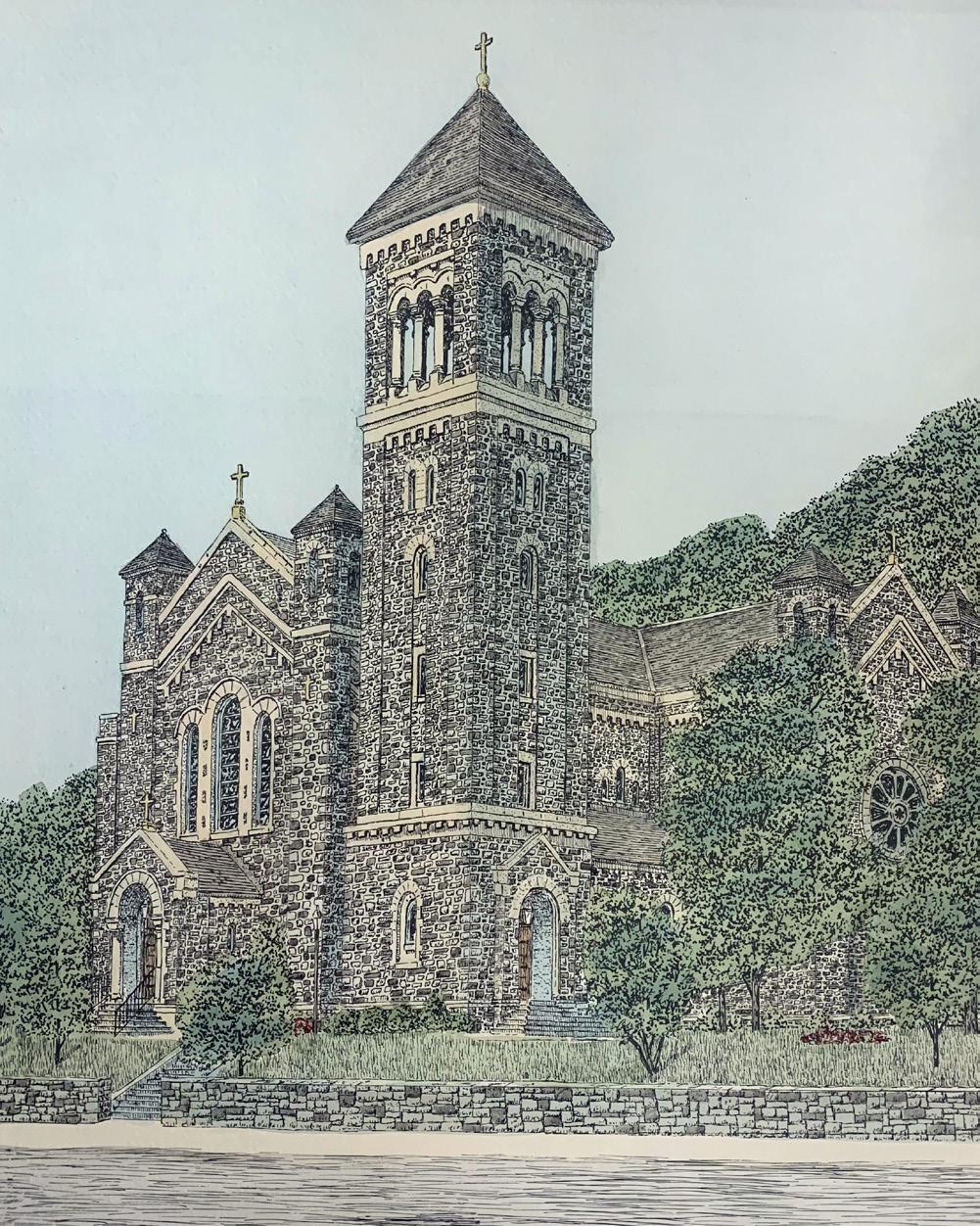
I am indebted to Mary Lawler, McKenna Snow, and Jack Daly for their tireless editorial dedication. A great deal of gratitude is owed to seminarian Michael Pray for his beautiful photography of our mountain home. The Intercollegiate Studies Institute, Chronicle Press, and all our contributors are dearly appreciated for their indispensable support. Thank you all for another wonderful semester of The Brownson Record.
O Come, O Come, Emmanuel!
Sincerely, Gavin Hamrick, Editor-in-Chief
4 The Brownson Record | December 2022
Letter from the Editor
"Emmaus-ing" Encounters
I hopped on the bus at 2am, and after a sleepy flight to Tel Aviv and a musical bus ride to Emmaus, I stood before ancient ruins surrounding an altar. This marked the very spot where it is believed that the Resurrected Jesus revealed Himself in the Eucharist to two of His disciples (Luke 26). It happened all that suddenly, and as swiftly as the sentences I used to describe it. And such were the nine days of my pilgrimage in the Holy Land. It was all a whirlwind— seeing so many places in so little time. And at the sites we were able to meditate and worship at, those tangible holy sites seemed yet somehow unreal and ordinary. There seemed to be a disconnect, between the graces offered to us and the physical places before my eyes. I do indeed mean to convey a sense of dullness that was included in my Holy Land experience. I want to be honest about it. But also let me clarify: I loved my time in the Holy Land. It was truly amazing (or, shall I say, "Emmaus-ing"). But what made this experience so amazing for me? Let me ask an even broader question: what would make anyone's experience of any place truly amazing? These questions can be answered in the same way: an encounter with an other.
That is what I see reflecting back on my time in the Holy Land: the best experiences we can have are of others. Even locations themselves- every nook and corner of creation- expresses in some capacity the Holy Trinity. The Holy Land is distinctly special for basically this same reason: namely, the Person Who descended there and those who experienced/encountered Him. The Incarnation-when Eternal and Omnipotent Being became finite and vulnerable man—will never
be fully comprehended. When I looked upon the ruins of Caiaphas' palace and descended into the dungeon where Jesus spent the darkest night-while these certainly moved me toward faith and love of the good God—it barely scraped the essence of the mystery. But I was blessed to do so. In my deficiency of spiritual insight, in my disconnect, I was able to sit there with Him, in His desolation.
God has united Himself to us by coming to us in a specific place. However, because Jesus came so we might be united to God through Him, He is now accessible all over the world. St. Theresa of Avila one time told her sisters that they were more blessed to sit before Jesus in the Blessed Sacrament than St Mary of Bethany was to sit at His feet. This is the even better "better part." Not to drink from Jacob's Well, in a crowd of bustling pilgrims, trying to imagine the encounter of Jesus and the Samaritan woman there. I did that. I had intensely looked forward to Jacob’s Well for months. I identify much with the Samaritan woman, and remember when Jesus crashed into my life. But being there, I did not feel a connection. It was more joyful and profound to converse with my companions on our long walk to the Mount of the Beatitudes, where we had holy Mass. All of creation is not as profound as one human being. We are the ones that can be springs of Living Water, not Jacob's Well, a literal hole in the ground.
It was incredible to behold the city lights surrounding the Temple Mount, to walk the road to Emmaus in the heat, and to bask in the water of the Sea of Galilee. How can I describe the privilege
Mary Lawler The Brownson Record | December 2022 5
of being able to receive Communion in the Sacred Tomb, to venerate the rock at Golgotha, to pray the Joyful Mysteries in the hill country of Judea? My mind could not compute these things, my emotions could not express them, they were beyond me. But in order to appreciate the goodness of any experience-- the taste of falafel (not awful falafel), the scent of incense, the sounds of children playing, the vision of sunset— first, we must be at peace with others and ourselves, or else we cannot find any goodness in anything. Jesus drawing near to those disciples on the road to Emmaus— that is what sets our hearts afire.
One of my favorite experiences, like this Emmaus encounter, was in Nazareth, a dirty and poor town, rather unpleasant. Such is the place our Lord became flesh, which expresses a lot about where He chooses to break into each of our personal lives. That day in Nazareth, I had been wishing for a Miraculous Medal; I thought about asking other pilgrims if anyone had extras; I also looked inside a Catholic shop to see if there was one I could purchase, though in vain. Three fellow pilgrims and I walked along the dirty, desolate cobblestone streets- along our way, we spotted a Friar walking along nearby. "Father!" one girl from my group called out. We spoke with him, and he walked with us. "Will you give us a blessing?" she asked, before he departed. Delighted to encounter students from his alma mater, he smiled, responded positively, and added, “I have a bunch of Miraculous Medals if you would like!"
Enthusiastically, I replied, "Yes!" Then he gave us a blessing, with the Sign of the Cross in Chinese; when asked, he shared with us that he had been serving the underground Church in China until recently. This tiny interaction was one of the most joyous for me.
I would like also to relate some encounters I had in Nablus, a Palestinian City of 300,000, majority of whom are Muslims, with a Christian population of 600. Who would have thought this obscure city, one that is not unfamiliar with political violence, would become one of my favorite places I have even been. I think it was because of the people-- the school girls who asked us if me and my companions had boyfriends and who took pictures with us for their Snapchat, leading us through the marketplace to their favorite dessert shop; the elderly parishioner who thanked us for our presence and coming to her tiny parish, calling us a gift from God and a great encouragement; the
young adults who hosted me and two of my friends, conversing with us on their rooftop well into the night, and eating a traditional Palestinian breakfast there with us in the morning. These moments were the mixtures of minds and hearts. While the settings afforded the opportunities, they were imprints, inventions of the people who lived there, and for the sake of those people. I want to go back for the people.
These little anecdotes, like many others which I could also recount, are all almost irrelevant to the holy sites around where they took place. I am not a gnostic—I do know the physical world is relevant. Indeed, I am Catholic: the physical reflects the spiritual, and the spiritual can elevate the physical. But do you know what the spiritual reality is? Spirit is personhood. That is the heart of the Holy Land: namely, the Sacred Heart, "which beats for you, in time and in eternity, in sync with yours."
I went to the very spot where our Lord said, "... the hour is coming when you will worship the Father neither on this mountain nor in Jerusalem…when true worshipers will worship the Father in Spirit and truth." Ironically, I believe the same Jesus wanted me to come to that exact spot. But not so that I could receive some passing feeling of connection or elation related to the place. But in order to encounter this Him, who is available to us independently from holy ground and gushy feelings. An experience like this, one away from the sites, was another one of my favorite: It was when Father Anthony, our shepherd and guide, had the bus pull over on the side of the desert road (not the same time we pulled over for a "male emergency," that was a different time) and we all climbed a hill overlooking the Jordan valley and the sandy mountain range across it, and sang praises to God, encountering Him in our hearts, in the emptiness of that remote place, away from it all.
Our Lord did choose a specific place to come to us, but now truly He is as present here as He is in the Holy Land. And so, I know, I am capable of encountering God even in my local McDonald's. Not to say that some places aren’t holier than others; not to say that some places aren't more apt for our souls (or bodies, as McDonald’s proves). What I mean to convey is this: the person who is my local hamburger flipper is more sacred than the empty tomb-- that dude flipping hamburgers is the reason there is an empty tomb.
6 The Brownson Record | December 2022
My town is another holy land where the Lord walks searching for the lost sheep. My town is the holy land where the same crucified and risen Jesus waits lovingly for me in the little gold box. He dwells there, not in
the Holy Sepulcher. So let us go to Him now in our neighbor and in the Eucharist. Let’s encounter this Other, His Divine Person. And be holy land where He abides.
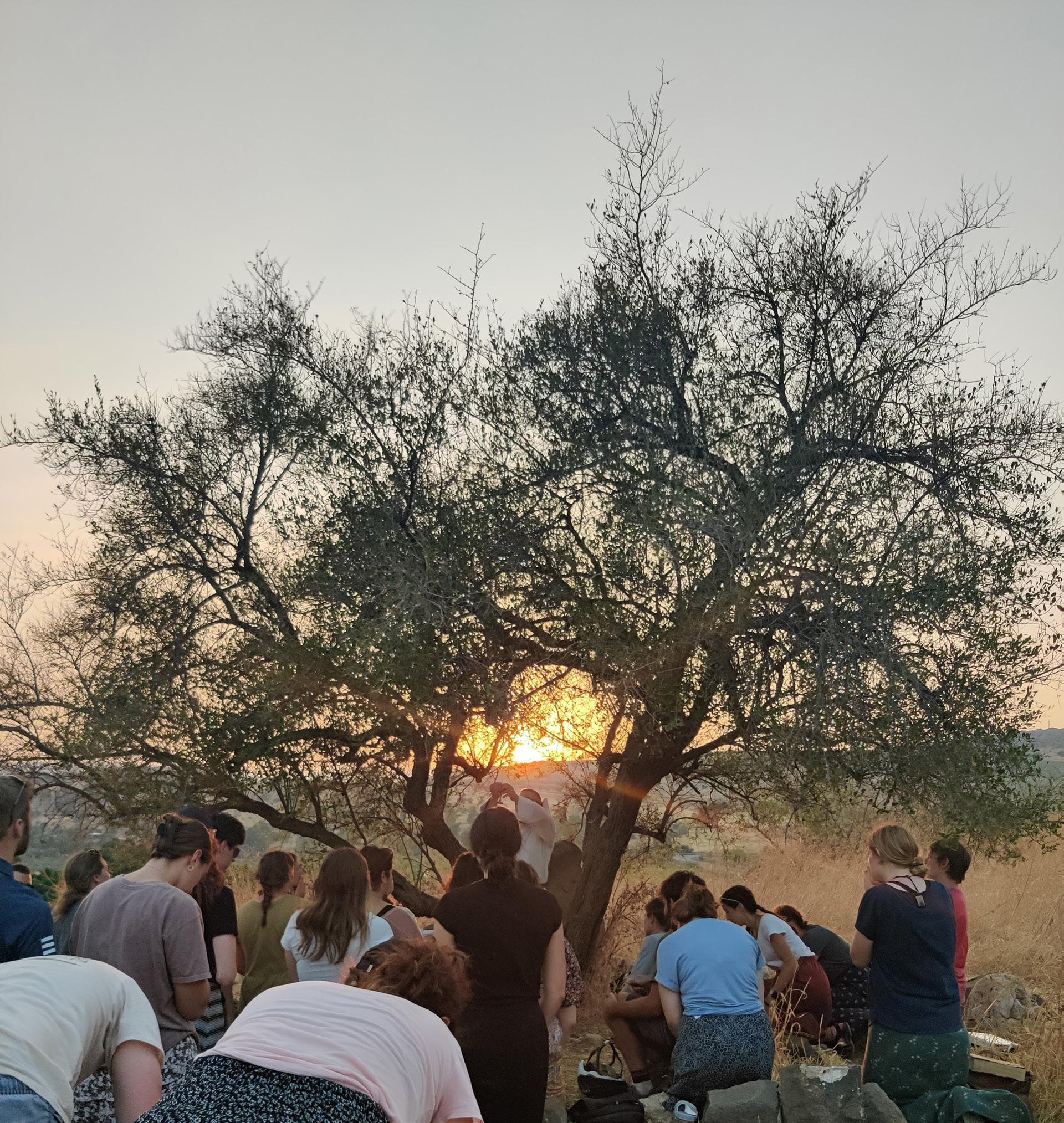
The Brownson Record | December 2022 7
The Mathematics of the Grotto
Discovered in 1805 by a French priest the 'grotto' at Mount St. Mary's is ground zero for a form of mathematics that holds the power to make something from nothing. What is a grotto-cave but empty space? Confronted by a formless void Father John Dubois reached into the darkness and affixed a cross, that orienting, optical instrument indispensable to seeing things clearly. From the dimness of a yawning chasm emerged something good, true and beautiful-a Catholic university. Today, at the center of the grottocave there remains a crucifix. To Catholics this image rivets the attention to the body at its center-Christ crucified. To mathematicians the intersecting lines of the cross create a 'point'-a seemingly empty spacethat is, in fact, the central generative engine for mathematical discovery.
Euclid began his treatise Elements by describing the unembellished 'point' as 'that which has no part'. He does not begin with the isosceles triangle or the square of the hypotenuse but with the geometry’s first essential term. More emphatically, the 'point' is defined as having no width, length, or breadth. As the song says 'Nothing from nothing leaves nothing'. Yet the point does contain one indisputable quality – location. The tiny, valueless speck as described by Euclid, is far from null. It is the starting point whose position is central.
Like the cave the insignificant 'point' is a black hole seemingly bereft of value. Yet it is the point, Euclid asserts, that begets the straight line and the profusion of geometric forms that flow from it. A line, postulates Euclid "is that which lies evenly with points
on itself". In nature there are no straight lines. Earth is spherical. Space is curved. Yet the advancements spawned from complex cultures-Egyptian pyramids, Roman columns, American GPS systems-owe their existence to the shortest route from point A to point B. Describing mathematical rules that govern reality Euclid’s geometry fueled material progress. Squares, triangles and rectangles proved indispensable to Greek civilization building. Yet, theoretical difficulty continued to arise, around shapes that had no sharp corners. Curvature emerged as a nemesis to the straight line. Are there straight lines in a circle? From the solitary 'point' the four cardinal directions can be drawn-north, south, east and west. From there an infinite number of ancillary lines can be added, with all points equidistant from the center, until the perimeter of a circle appears, strangely reflecting the contours of the prismatic eye that beholds it.
Invented in Greece, the wagon wheel, is widely touted as the greatest technology ever conceived. But what is a wheel without its axle? How then to steady a spinning disk and capture its furious rotation without the still-point at its center? What is Euclid’s infinitesimal 'point' but a circle with zero radius? A building block for flat surface geometry, Euclid’s unyielding 'point' would prove to be a foundation stone for higher forms of mathematics to come.
Like Euclid, Rene Descartes obsessed over a 'point' when he was a boy. It was a 'fly' on the ceiling. To determine the insect's location mathematically he measured its position by its distance from each wall. By this method of intersecting x/y coordinates to
John Singleton, C'86, MBA'87 lives in Annapolis, Maryland with his wife Karen. They have been married for 29 years and have three sons.
8 The Brownson Record | December 2022
Grace Germain John Singleton
Mary
identify a position in space he created the Cartesian plane.
Without knowing it the religiously skeptical Descartes had recapitulated a familiar form. The Cartesian plane is a cross upon which points are plotted and reality is observed. On its shoulders nature is harnessed and science is conscripted to the service of mankind.
Descartes pioneering crosshairs fueled a new era of mathematical advancement providing the first systematic link between the static objects of geometry and the abstract equations of algebra. Calculus, too, arose from this regulating axis accelerating mathematics past the world of objects with its sweeping power to measure invisible forces like the speed of light and the motion of the celestial bodies.
In the beginning there was a ‘point’ of infinite density that existed in a void containing all the matter and energy of the universe. The explosion that rippled outward into all four directions, known as the Big Bang, created time and space. First proposed
by Belgian scientist Georges Lemaitre the ‘Primeval Atom Hypothesis’ described an expanding universe, constantly receding with an indisputable beginningmiddle-and-end.
The detonation of a single point of immeasurable mass became more problematic when the catalyst for igniting such an explosion was considered. Such a phenomena sounded overtly theological to Lemaitre’s contemporary Albert Einstein. The famous Germanborn physicist wasn’t going there. But the priest who earned a PHD from MIT had no problem dividing his attention. By reconciling two divergent disciplines –science and religion – Lemaitre demonstrated multiple ways of arriving at a higher truth. As a man of God, Lemaitre knew that the reconciliation of opposites is not a difficulty to be avoided but an invitation to be answered.
When Father John Dubois was beckoned by a point of light he followed it. Stumbling into an arboreal ‘grotto’ he discovered what would become ground zero for a great Catholic university. On many Catholic
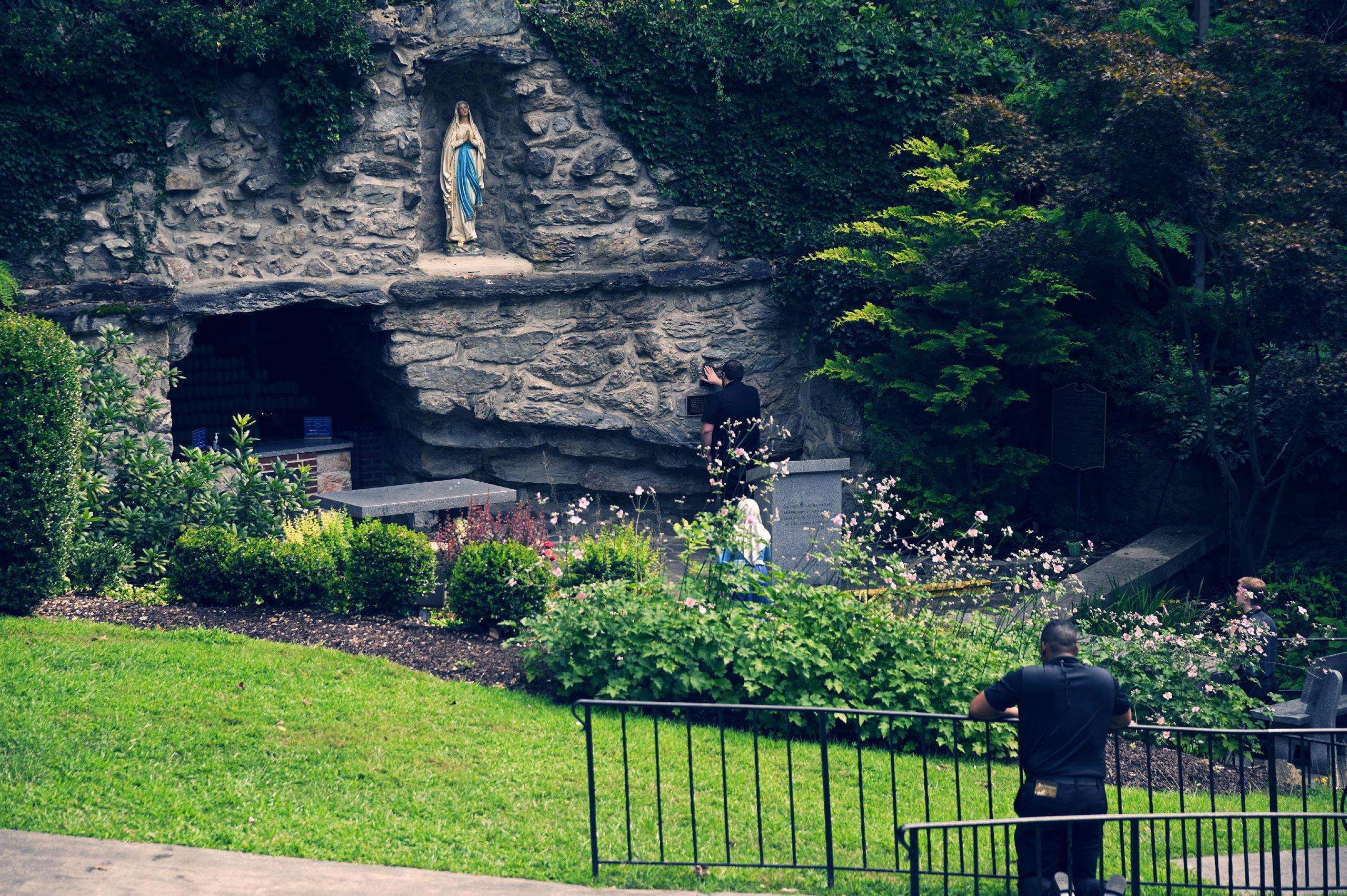 Photo of the Grotto by Michael Pray
Photo of the Grotto by Michael Pray
campuses a relic of Catholic topography remains. A grotto-cave invokes the storytellers of old, who approached the mystery of 'empty space' as a nascent potentiality not a lifeless nullity. For Christians the cave is the place where Jesus Christ threw off the chains of death-a mathematical 'singularity' describing an experience where our equations stop making sense.
Turning dead fiber into living flesh presents a similar singularity. Located at the center of the Catholic Mass the superposition of the Eucharist signifies a sacrifice, a place where an exchange with the unknown is made for the sake of a divine mathematic. The indispensable 'point' of Euclid’s geometry, the immoveable axis of Descartes 'cross', and the mystery of the Eucharist are not just singularities but are the central generating engines of civilizational advancement and the keepers of reality itself. At the still-point of two clashing and contradictory lines resides a paradoxical location at whose center we are always aiming because that's where the truth can be found.
When the Fathers of the Church launched the
world's first universities across Catholic Europe they applied the same time-tested mechanism for spiritual inquiry across all disciplines-theology, philosophy, mathematics and the sciences. In a material world where there are no straight lines they must be imposed by a foolproof framework embedded in the navigable periscope of the sea captain, the optical telescope of the physicist, the magnifying microscope of the biologist, and the range-finding cruciate of the theologian.

To conceive of a venture is to measure its potential through the intersecting lines of the optical lens. At the center of these reticle crosshairs presides a mysterious, focalizing pupil-a dark cave-that has the capacity to transform chaos into order.
In the Grotto-cave at Mount St. Mary’s the center holds confirming that all of creation hangs on a 'singularity'-an inconsistency of logic. The mathematics of the Grotto embraces the potential of empty space, making room for the impossible to be done at the locus of causality where a negative becomes a positive.
10 The Brownson Record | December 2022
God Came to My Assistance
As I do almost every night Monday through Thursday, I head to the dorm room where Night Prayer, or Compline of Liturgy of the Hours will be prayed. In the apartment, every effort has been made to make guests feel welcome; bright string lights run across the ceiling and a vase of flowers sits near a jar of candy on the table. A kind voice beckons me to sit on the couch, and we chat for a moment as people file in–students of all class levels, some coming from the 9:00 Mass, others from the library. For some, this nightly prayer as a community, partaking in the time-honored Catholic tradition of marking and blessing the hours in an otherwise hectic college life is the most treasured part of the day. From my vantage point as a senior, I am suddenly awestruck when I remember that night prayer on the Mount campus began three years ago with two of my friends, Mary Grace and Olivia, and has expanded to often more than a dozen people. The leader clears his throat. “God, come to my assistance.” In a chorus comes the response: “Lord make haste to help me.”
Presence. That’s a word I’ve been thinking a lot about these past weeks, asking myself what it means to have been welcomed into the Catholic community at Mount St. Mary’s, to remain in it for a time, and to soon be leaving. Will this community continue to be present in my life, and if so, how?
The Mount’s Catholic community, Campus Ministry in particular, has been a central part of my college experience since the second weekend of freshman year when I attended a party off campus at the FOCUS missionaries’ home. I pinpoint that night
as the moment I truly felt welcome on this campus, when it seemed that everyone wanted to introduce themselves and to know my name. My name. In years past I had often felt excluded but now I was seen, and soon, through friendships that began that very night, shown not only that I was worthy of love but that I was immensely loved.
In time I came to see that what keeps the Mount’s Catholic community vibrant and coherent is that it is fundamentally one of joy. Don’t get me wrong; we have daily struggles and great hardships, we are sinners needing God’s grace, but we know that Christ’s love is strong enough to lead us to victory. And each person fills a unique part in this community. I, for instance, embrace my own gifts but also am at times tending toward melancholy and anxiety, yet it is the exuberant joy of those who are more outgoing, who live their faith a bit more out loud than I, that has lifted my spirit many a time. When I think of these specific people the words of Pier Giorgio Frassati come to mind, his response to someone who asked if he was happy: “How can I not be happy when God is the center of my life?”
Even if my time in this community will last only six more months, my time here will continue to provide meaning in the life lessons I will take with me. Upon reflection, I saw that they fall into three broad themes:
1) None of us has to carry our cross alone. Fall semester of junior year I was going through a particular stressful and exhausting time filled with a full courseload, two on-campus jobs, and worries in
Emma Smith
The Brownson Record | December 2022 11
my family situation. One day the Gospel came from Matthew chapter 11, in which Jesus instructs His followers to “take my yoke upon you…for my yoke is easy, my burden light.” This made no sense to me and I found myself questioning God’s word. The very next day, an acquaintance volunteered to assist me with some physical labor, and I was reminded of the fact that it was not good for man to be alone, that we are meant to share each other’s burdens and to walk with one another, quite literally, on the road to heaven. (Galatians 6:2)
Later that year I found myself struggling with a faith-related fear, feeling very isolated in darkness and uncertainty. One evening, by chance, I found out that a good friend of mine had previously struggled with the same fear. We had lived side by side for three years but knew nothing of what the other was going through; when we learned of it, a period of healing for both of us was ushered in. By bringing this to the light we were able to carry our crosses together and be a conduit to each other of the hope that is found in Jesus.
2) I have learned that despite all the good things a community like the Mount Catholic community can provide, no one or group of people can truly fulfill me but Jesus. In my time here what I noticed growing up was confirmed: people disappoint me. There is that temptation to think that if I just get to know this person a little more, if this person shows an interest in me, if all my friends are together in one place having fun, then I will be fulfilled. These things happen and I find that there is still more to learn about this person or that there is still a longing in my heart for more
community, but of a different sort. It is at these times that I am reminded of a piece of wisdom I received from a former seminarian here, Esteban. When he came to the Mount he knew no one and asked Jesus to be his best friend. Surprisingly, I felt a bit like that starting my senior year. My best friends had graduated and, afraid of being lonely, I too told Jesus that He must be the one there for me. This has helped me to grow in trust but also as a reminder that no one knows me better than Jesus, that Jesus longs to be my most important relationship and the one who will ultimately fulfill me in heaven, and that is why our hearts yearn for a reality we cannot yet possess. In the meantime, God has placed people in my life to help me on that path toward unity with God.
3) While my time at the Mount is almost done, I have learned one final valuable lesson here: that the Church is truly universal and I will find it wherever I go. Before entering college I never dreamed that I would meet so many committed Catholics here at the Mount or in Guyana and Colorado, places I’ve traveled to on service trips. The Church is a large and a small place at the same time. Just as God has placed new people in my life before, He will do so again when I graduate. God provides for His people, and knowing that I personally find His presence in the examples of other people, He will provide for me. The fact that I might have to lean on Jesus’ strong hand a bit more than usual will only allow me to better see His love and care in my life.
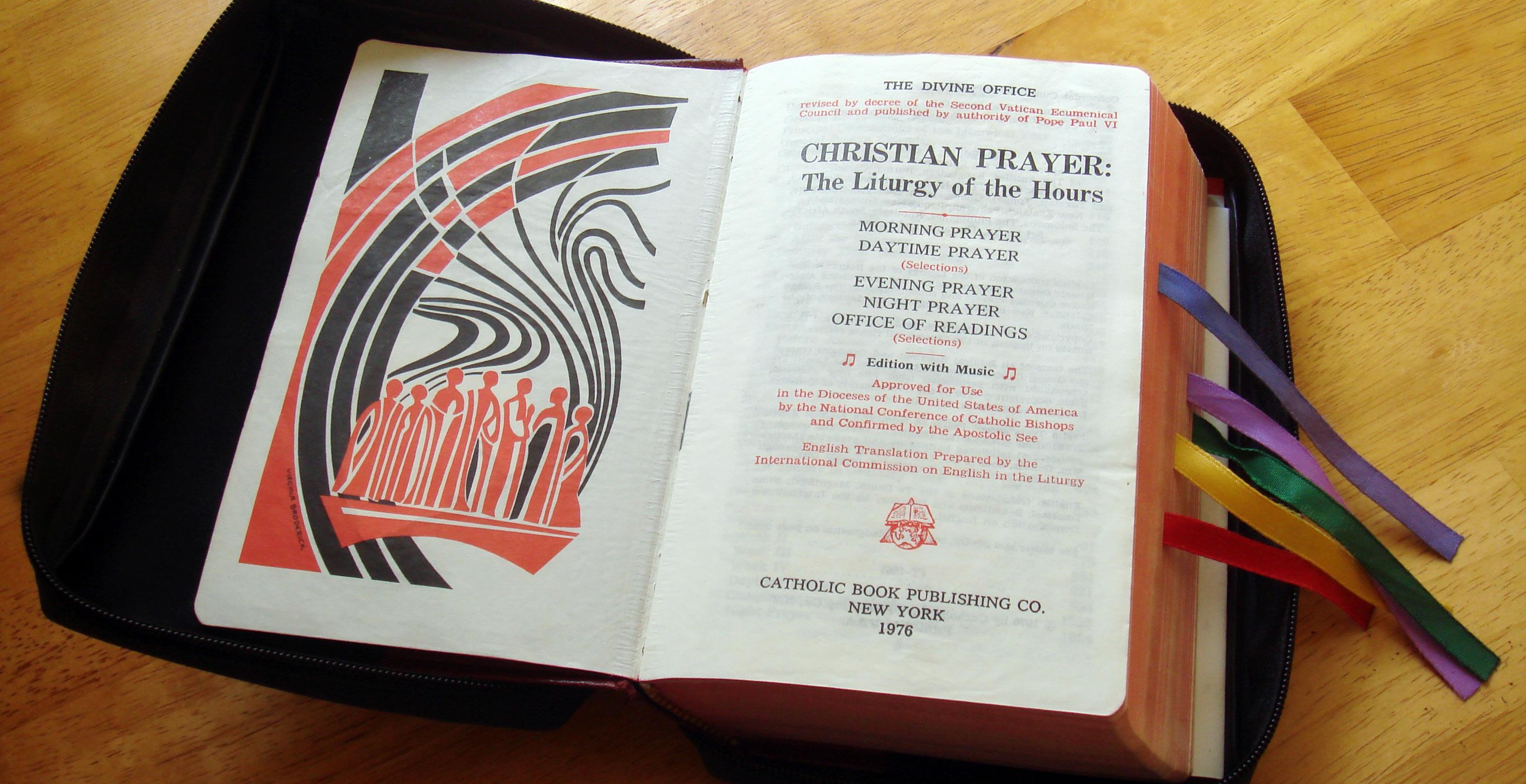 Photo of a breviary by Joe Gallagher. CC BY SA
Photo of a breviary by Joe Gallagher. CC BY SA
2.0
The Role and Limitations of Philosophy in the Abortion Debate
The question of the permissibility of abortion stands at the intersection of a multitude of ontological, ethical, legal, religious, and historical debates. What the right to life consists in, what bodily autonomy entails, the role of religion in politics, the definition of liberty, of life, of humanity, etcetera, etcetera. Encompassing such a broad range of topics, one may wonder where the sciences fit into this discussion. With their insistence on empirical verification, their methodological guarantee of objectivity, their unparalleled success in investigating the physical world, surely they must take center stage - right?
As a matter of fact, they’ve been more or less silent on the issue. But it isn’t that they have nothing important to say. Rather, their influence has been diminished by pro-abortion advocates who ardently insist that the term "person" and the phrase "[living] human being" are not coextensive. In other words, they claim it is possible to be a human being and not also necessarily be, by virtue of being a human being, a person with intrinsic value and inalienable rights and liberties. The result of this is that if the biological sciences are able to objectively determine what a living human being is, pro-abortion advocates can claim these findings are irrelevant because “human being” doesn’t equate with "person."
What is to be made of this? Are there issues with this view? And if so, are there alternative frameworks that allow a greater say to the natural sciences? Answering these questions requires a foray into the historical and philosophical roots of this distinction.
John Locke, in An Essay Concerning Human Understanding, laid the groundwork for the modern distinction between a human being and a person. He writes, "person stands for… a thinking intelligent being, that has reason and reflection, and can consider itself as itself, the same thinking thing, in different times and places… [by means of] that consciousness which is inseparable from thinking, and [is] essential
to it…" In other words, what makes me me is the implicit conscious recognition that I am myself and not something or someone else. Locke continues, "Self is that conscious thinking thing… which is sensible or conscious of pleasure and pain, capable of happiness or misery, and so is concerned for itself, as far as that consciousness extends." Indeed, "[the] self is not determined by Identity or Diversity of Substance… but only by identity of consciousness." Locke makes these remarks in the context of diachronic personal identity, but what can be gathered from them is that to be a person consists solely in having temporally continuous subjective experience. Nothing beyond this subjective experience, like facts about one’s genetic makeup, physical characteristics, personality traits, or anything else that the natural sciences could investigate, matters for personhood. As philosopher Derek Parfit observes, "Locke claimed that, if I was conscious of a past life in some other body, I would be the person who lived that life."
The main point, however, is that personhood, "[in which] is founded all the right and justice of reward and punishment," is in principle separable from the fact of one’s being a human being. That is, being a person and being a human being, for Locke, are not necessarily the same thing. Robert Pasnau remarks summarily that, "Locke carves out the notion of a person, as something distinct from the biological human being, to be analyzed… in terms of psychological continuity." It is the possibility of this distinction that Locke has bequeathed to the abortion debate.
Now, this is not to say all pro-abortion advocates are claiming that personhood is grounded in conscious recognition of oneself as a persistent thinking subject. On the contrary, pro-abortion advocates do allow the biological sciences some input insofar as they often attempt to ground personhood on empirically verifiable characteristics. However, disagreements on what these
The Brownson Record | December 2022 13
Quinn Gerney
characteristics and the criteria for personhood are significantly diminishes the efficacy of the sciences.
Justice Harry Blackmun, for instance, remarks in the majority opinion on Roe v. Wade, "The Constitution does not define 'person' in so many words. The use of the word is such that it has application only post-natally. None indicates, with any assurance, that it has any possible pre-natal application." Blackmun later considers when a fetus has the capacity for what he calls meaningful life, noting that "[w]ith respect to the State’s important and legitimate interest in potential life, the 'compelling' point is at viability. This is so because the fetus then presumably has the capability of meaningful life outside the mother’s womb. State regulation protective of fetal life after viability thus has both logical and biological justifications." Here the relevant criteria is the vague and ever changing threshold of viability-currently considered at around 24 weeks gestation. Others have invoked cardiac activity as the defining characteristic of a person. Typically, the electrical impulse productive of a heartbeat begin to occur at around 6 weeks gestation, but this itself elicits further disagreement on how to define a heartbeat (as crazy as that may sound). Still others bring up autonomy or the capacity to react to external stimuli as the relevant criteria. But, regardless of their differences, insofar as the present discussion is concerned, all of these views amount to the same thing. They each posit some more-or-less arbitrarily selected, empirically verifiable property as the criteria that makes a human being a person. But unless there can be some agreement on what this criteria should be, the sciences will remain shut out of the discussion.
Given these disagreements and the ethical issues they potentially give rise to (for instance, Chief Justice Roger Taney’s ruling in Dred Scott vs. Sandford that enslaved African Americans, weren’t "people" with the "rights and privileges" ensured in The U.S. Constitution), perhaps the important question should be; are there any good reasons to think a human being can be different from a person in the first place? What if the belief that such a distinction is even possible is rooted in a more fundamental philosophical error? To offer a solution to this hypothetical error would be to offer a greater say to the natural sciences in the abortion debate-a tempting prospect. What then, might this error be?
The 14th century logician, William of Ockham, famously remarked that "the tendency to multiply entities according to the multiplicity of terms, so that for every term there is a thing… is a wrong-headed approach, and… it leads one [away] from the truth." This (not the oft-repeated claim that the simplest explanation is the most likely) is known as Ockham's Razor. The point Ockham is making, insofar as concerns us, is that there’s a difference between the meaning and the reference of a word. And when meaning is confused with reference, people are led to believe that more, and different, things exist than there actually are.
For instance, consider the words "triangular" and "trilateral." The word "triangular" means having three angles that add up to 180 degrees. The word "trilateral" means having three connecting sides. However, anything that is triangular must also be, necessarily, trilateral. They both refer to triangles, and only to triangles, in spite of their different meanings. Again, difference in meaning doesn’t necessarily entail a difference in reference. In this case a difference in reference would be altogether impossible, as a matter of fact. Could this then be what is happening with "person" and "human being?" The issues noted above about the inability of interlocutors to settle on definite criteria that make a human being a person gives good reason to think this is what the problem may, in fact, be. What is needed however, is a complete and sufficient account of how it is that "person" and "human being" are co-extensive.
Enter Aristotle and St. Thomas Aquinas. The traditional Aristotelian-Thomistic (hereafter, A-T) metaphysical and logical framework offers serious advantages in regards to the current debate. For not only does it provide an exceptionally robust and fine-grained semantic theory to accommodate the distinction between meaning and reference, it also gives free reign to the natural sciences in determining what things are and what physical features these things have. This may sound doubtful to some "scientifically inclined" readers who have some basic familiarity with A-T metaphysics and logic. And sure, prima facie, the language in which the A-T system is formulated is rather unappealing to a modern audience. But a deeper understanding of what this language is trying to convey reveals it to abide quite well with common
14 The Brownson Record | December 2022
opinion and a scientific understanding of the world.
Of particular interest to the current discussion are the A-T notions of form and soul. While the former may conjure up images of some Platonic "heaven" and the latter images of ghosts or spirits, neither involves any such "spooky" entities in any way. As a matter of fact, this is precisely where the genius of the A-T system lies. A form is just whatever it is about a thing that makes a certain definition or description true of it. For example, the form red is what makes the descriptive word "red" true of an apple. In a similar way, for the word "dog" to be true of a thing is simply for that thing to have the form dog. It is simply for it to be a dog.
On the other hand, a soul for the A-T philosopher is a certain kind of form in living things. St. Thomas Aquinas remarks that "soul is the first principle of life." That is to say, a soul is the form that makes the word "living" true of a thing. It is, for the A-T philosopher, merely another word for, say, the form dog. Or the form man. And upon reflection this is rather intuitive. What is a man or a dog? They’re living things, of course! To be a dog is to be a living thing. To be a man is to be a living thing. Granted, they each live in different ways and have different properties and characteristics. But to discover what these differences are, exactly, is not the task of the philosopher. Instead, this falls to the natural sciences.
This shows several things: first, the same thing can be referred to by different words that express different aspects of it. Second, the natural sciences are intimately involved in the A-T account. They provide exact descriptions of what the forms of things are. And third, for a living thing to start to be what it is, is just for it to become alive. That is, for a dog to be a dog, or for a man to be a man, is for the certain kind of thing that they are to come into existence. And for a living thing to start to exist is for it to start living.
What does this all have to do with the issue of abortion, however? Well, consider that what is meant by "person" in the context of this discussion, as alluded above, is just a thing with intrinsic value. That is, a person is a thing that is valuable by virtue of being what it itself is. In other words, it is valuable by virtue of its form. But what is the form of things typically regarded as "persons?" Human beings, of course! We typically assume that human beings (e.g., you, me,
King Charles III, and whoever else) are persons. But that means they are persons by virtue of the same thing that makes them human beings-viz., their form! What this all means is that a thing becomes a person at the same time it becomes a human being and, because a human being is a living thing, this all happens when the thing starts living. So the words "person" and "human being" are, assuming no nonhuman things are persons, coextensive.
The upshot of this is that the natural sciences are in a position to determine what a person is, by virtue of being able to determine what a human being is. And the question relevant to the abortion debateviz., "when does a person with intrinsic value start to exist?"-just becomes the question of when a human being starts to exist. And a human being starts to exist when that distinct organism begins living. When does a human begin living? The sciences can tell us: during the process of fertilization, where two distinct organisms (ie., the sperm and the egg) combine to produce a third distinct organism, a zygote, a human being.
Thus, there is a rather simple and scientific solution to the problem which seems to confound so many. The post-Lockean distinction between a human being and a person unnecessarily muddles the issue. Let philosophy lay the groundwork for the noble task of the sciences. Like Virgil, the A-T philosopher can only lead the sciences so far. As they venture onward to truth, let them recall his words:
“Here I have led you, by skill and art: now, take your delight for a guide: you are free of the steep path, and the narrow. See, there, the sun that shines on your forehead, see the grass, the flowers and the bushes, that the earth here produces by itself… Await no further word or sign from me: your will is free, erect, and whole—to act against that will would be to err: therefore I crown and miter you over yourself.”
(Purgatorio, XXVII)
The Brownson Record | December 2022 15
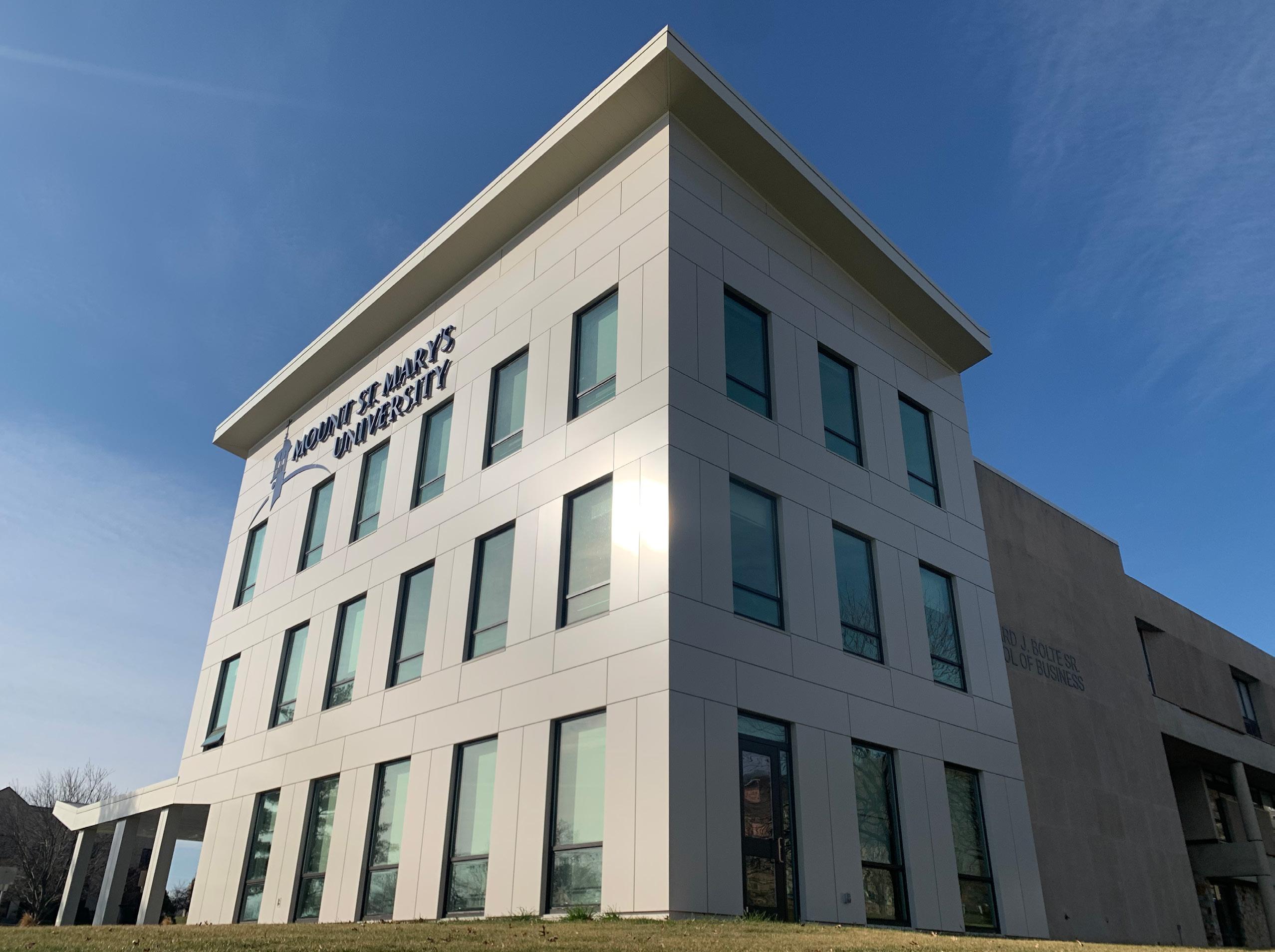
16 The Brownson Record | December 2022 Please Stop Making Ugly Buildings, Young People Don't Want Them McKenna Snow
What is the purpose of architecture? Is it merely to facilitate an indoor space for human beings to use? Or, is it only to express grandeur, despite impracticality? Are there buildings that can do both? Of course, you say—there are lots of beautiful, practical buildings. What are some that come to your mind? Keep the radius small, and just think of the Mount’s campus: what buildings come to mind that are both beautiful, and very practical?
My thoughts immediately go to Immaculate Conception Chapel, the Science building (or the COAD, as STEM majors call it), and Bradley. The Delaplaine, Terrace, and even the Library also make the list.
Now, on to the next question: why didn’t the PAC come to mind? Why didn’t the new Welcome Center come to mind? Or the new, gleaming expansion of the Knott Academic Center?
In recent years, Mount Saint Mary’s University has invested extensive time, effort, and money into the expansion of the Academic Center, the PAC, and other new buildings. The students have watched as the new Frederick Health Center was built up across from Powell. The new Welcome Center sits behind the Delaplaine.
The reason these buildings didn’t come to mind when I asked about beautiful practical buildings is because, quite simply, they are not that. They are just buildings. The Mount is suffering from a need to keep up with modern architecture trends, and it is a project that is sorely unwise. For example, the new extension of the AC is a stiff geometric clip-on to the original building that offers no decorum to the exterior. The roof juts upwards surprisingly, as if at the last second; perhaps it is an attempt to provide some “movement” to the many glass rectangles that comprise the walls. Real creativity winces in pain at the sight of it. Right across the sidewalk, so to speak, the PAC stands proudly as another 3D rectangle, with garage-style doors and glaring jumbo-sized televisions on either side.
When I explored the interior of the renovated AC with my friends for the first time, I wanted to be impressed and was excited to see what was new. Walking up to the third floor, however, I felt that its new foyer felt more like an airport terminal than a place I would go to for the sake of itself; for me, it is only a means to get somewhere else. It offers me no invitation to stay
awhile; the harsh overhead lights question me as I walk by to my classes, offering me a seat at the striking blue synthetic chairs, and threatens to steal all creativity from me if I stay for too long. Why? Because it has no beauty within it. The interior of the third floor of AC has caved to modern art’s love of abstract, impersonal accent pieces and harsh lighting. The exteriors of these new buildings have not fared much better.
A visitor or onlooker driving on 15 normally encounters t he PAC and the Frederick Health building first, since they are closest to the road. This means that their first impression of the Mount is a lack of vision, and a lack of beauty. They just encounter buildings, and nothing more. If a visitor was to take a walk around campus, he’d have to travel up the hill to truly be inspired. Going up the hill, the visitor meets the COAD, a stately building made of stone. Columns introduce the onlooker to the main entrance of the building, and grand steps to the doors symbolically remind you that in order to embark on a scientific endeavor, you have to be willing to elevate your intellect first. In a single glance, the whole building sends a brief introduction of what it means to engage with science. Then the visitor encounters Bradley. What a sight! The flags in front, accompanied by the Mount’s iconic sign, don’t allow him to consider the building without a grand announcement of its identity first. And then magnificent stairs, again! These stone stairs invite from both sides and connect halfway up, forming a grand escort up to the veranda. The building is dynamic, impressive, and speaks about its duty as the administrative building. It is a building fit for a President to reside in for his daily duties. The bottom floor’s doors are shielded politely by arched awnings, and accented with chairs not tainted by modern art’s belief that a piece of furniture should look as nonshapely as possible. They still have four legs, arm rests, and long, supportive backs. The modern chair would claim it must look as non-chair like as possible while still being a chair: remove the arms! Do away with half of the legs and let a new, sleek designed feat of engineering support the seat with just two legs! I encountered this same chair on the third floor of AC post-renovation. The need for beautiful architecture arguably applies to furniture, too.
The Brownson Record | December 2022 17
And then, walking past Bradley, the visitor comes to find my home, Terrace. I have lived here for three years, out of request during RA placement. The building design is my favorite out of all the residence buildings, and who can blame me? Four stories tall, consistently made of stone that matches Bradley, the library, IC Chapel, the COAD, and Patriot, the Terrace fits in beautifully. The building is shaped like an L, the longer part of it facing out at the library and the rest of campus. The visitor can walk along the Terrace plaza, stop for a while at the lovely gazebo inbetween Terrace and the breathtaking chapel, and then pick from several entrances should he want a tour of the inside. The Dubois entrance has its own sort of lengthy porch, introduced by stairs on both sides up to the second floor of the building, taking away any chance of a static entrance into the building. I love the porch because it doesn’t have to be there. Not many people will “hang out” on the porch, so to speak, or on the little veranda Mac’s side has to offer, but I love it because it adds life to the building. It adds an element of character that modern art would say to take out from the design of the building because it doesn’t “do” anything, practically speaking. But that is the point, isn’t it? Beauty is “practical” for its own sake, not for the sake of utility. Beauty inspires joy and delight; sleek, mechanistic buildings offer no such inspiration. Beauty doesn’t need to prove itself useful through a productivity sheet; all it must do is be delightful to the human being who encounters it. God has created this world beautifully; the work of human hands should reflect His love of beauty as much as it reflects the truth of the goodness of work.
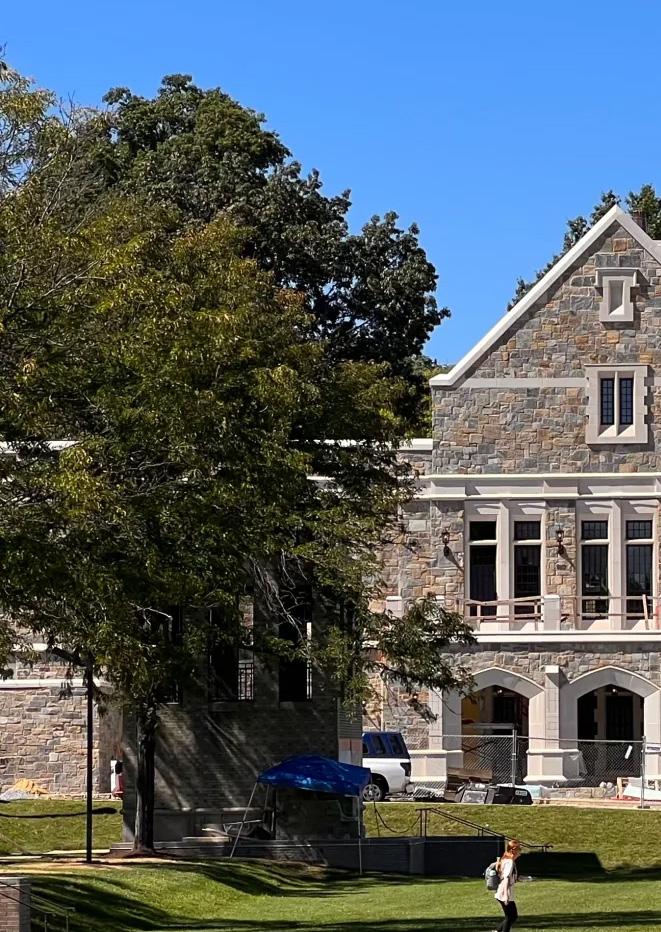
Terrace’s first three floors share in common the many windows of the dorm rooms, but are crowned with a homey grey-roofed fourth floor that playfully boasts of triangles window-tops that are all neighbors to each other. The Bruté section of the building’s windows are deeper-set than Dubois’, telling the onlooker that there isn’t something dreadfully utilitarian about this living space, but rather that each room is, in some small way, its own. Finally, Terrace’s iconic largest triangular statement is in the Dubois section of the about-facing building, fitting in three smaller windows beneath its outline. It is topped by the iconic white cupola, capped with a green dome, and crowned with a golden cross. Does anyone ever use that tower? Not
from what I have ever seen! But should we tear it down to give the residence buildings a sleeker, more modern look? Never, I ask the future architects of the Mount— please never tear my beautiful Terrace home down. All of this is to say, I am no professional architect. As is likely clear from the vocabulary of this article, I don’t actually know much about architecture. But I am a young person who notices when her campus begins to be afflicted by modern art trends. I know that these new designs will not stand the test of time; give it twenty years and the interior of the AC will need to be renovated again so that it feels “fresh.” I see beautiful classical libraries and classrooms of other liberal arts schools and know they will continue on and will be recognizable by alumni even many years later, and cherished by the current students. Young people want beautiful buildings, and we want beautiful interiors to reside in and to work in. I would go work in the Theology Department’s conference room, amidst its red-brown bookshelves and long, deep windows because it inspires me to think higher. I rarely work
18 The Brownson Record | December 2022
in the AC classrooms, or in its third-floor airport terminal, unless I absolutely have to, because the drab beige walls, devoid of beautiful art or creativity, offer me no support in my academic pursuits.
Young people notice when a room or building is ugly or when it is beautiful. We do not have to have a degree in architectural studies or classical architecture to be able to recognize when something is missing from the new buildings on campus—and perhaps we cannot articulate our concern and desire for beauty all that well, but here’s to trying. I have hope that the Mount can continue expanding and renovating our campus while striving to match new projects to the cherished designs of Terrace, Bradley and the COAD. We know our mountain home well enough to design buildings and renovations that exemplify her best visual qualities, rather than harshly ask her to leave these comforting designs behind for this decade’s fleeting trends. We want beauty, delight, and joy, even in these campus buildings; so please stop making ugly buildings, young people don’t want them.

The Brownson Record | December 2022 19
Photo of the recently constructed Garvey Hall at The Catholic University of America by Tom Shakely. Garvey Hall opened on December 5th, 2022.
Poetry
Morning Light Claire Doll
Sometimes, I think the sun rises just because it loves the color of a pink-lemonade sky spilling into the edges of the earth, the golden light illuminating a honey-dappled world. The sun rises for silence, for brewed coffee on counter tops, for eggs with runny yolks and open windows letting in air touched by autumn. And for moments before blue takes over the world, the sun rises and daylight takes shape, and gold emerges from the horizon.
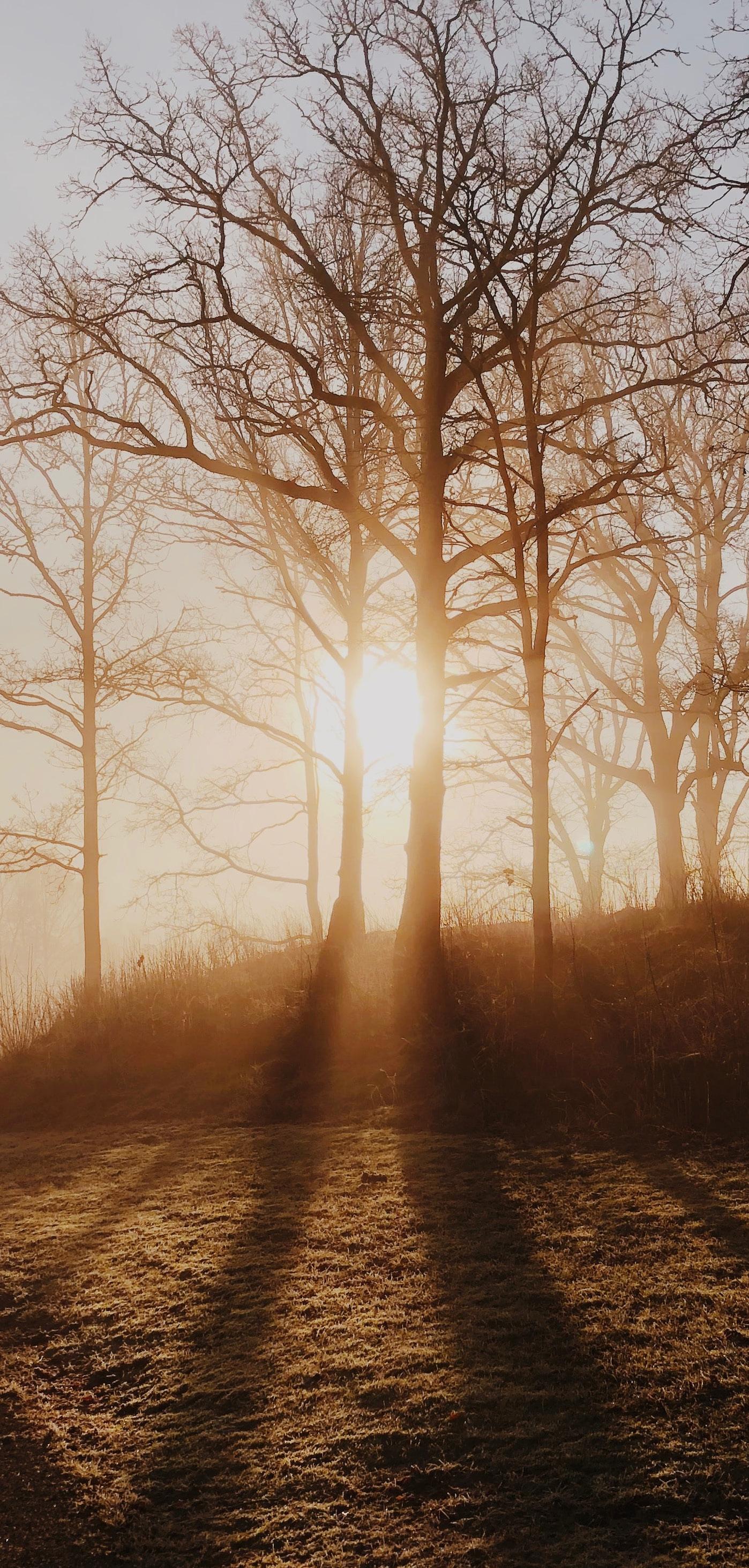
Haiku for the Solemnity of the Immaculate Conception Michael Lennox
Our fairest Lady Magnifying God's glory Saint above all saints
20 The Brownson Record | December 2022
The Immaculate Conception: Our Model of Holiness
Think of the first time you walked into the Mount’s Chapel of the Immaculate Conception or any large Catholic cathedral. When you walk into a great church, you encounter the majestic enterprise that is God’s work. How fitting it is that the sacred space where we meet God must be as magnificent as the one to whom we behold. So too, God’s first temple on earth must be all the more beautiful. When the Son of God took flesh and became incarnate in the Blessed Virgin, he willed that his first dwelling place be pure and stainless. On December 8, the Solemnity of the Immaculate Conception, we celebrate the belief that Mary from the first moment of her conception was preserved from all sin by the merits of Jesus’ life, death and resurrection. This good news should give us a cause of joy knowing that "with God all things are possible" (Matthew 19:26). Amidst our brokenness, which is better: to despair at our human frailty or to hope in what God can do when we run to him. We in our journey of sainthood must look to Mary in her immaculate splendor as the model of holiness to which we aim and the principal patroness to whom we implore.
First, who is Mary under the title of the Immaculate Conception? On December 8 1854, Pope Pius IX defined the dogma of the Immaculate Conception in a masterful apostolic constitution. In Ineffabilis Deus, he proclaimed, "The Most Blessed Virgin Mary was, from the first moment of her conception, by a singular grace and privilege of almighty God and by virtue of the merits of Jesus Christ, Savior of the human race, preserved immune
from all stain of original sin." Mary was granted a special grace from God by the future merits of Christ. She was exempt from original sin and this exemption began at the first moment of her conception within the womb of her mother. Thus preparing her to be the Christ-bearer.
The Catechism of the Catholic Church says, "The Father blessed Mary more than any other created person 'in Christ with every spiritual blessing in the heavenly places' and chose her 'in Christ before the foundation of the world, to be holy and blameless before him in love'" (CCC 492). Her total sinlessness was not for her, but was all for Jesus and all from Jesus. We should honor Mary in the same way God honors her. However, why does she hold this special privilege from God?
To understand the predilection God has for Mary, we go back to our beginnings. Immediately after the fall of Adam and Eve, we find a beautiful response to the first sin of humanity. In Genesis 3:15, also called the "Proto-Evangelium," which means the "First Gospel," God speaks to the serpent and sets the stage for the whole story of salvation. The verse states:
"I [God] will put enmity between you [the serpent] and the woman [Mary], and between your [the serpent's] seed and her [Mary's] seed; he [Jesus] shall bruise your [the serpent's] head, and you [the serpent] shall bruise his [Jesus'] heel."
God says that there will be a woman who will be actively opposed to the enemy that is the serpent. This woman cannot be Eve, because she has already succumbed to the serpent’s trickery. Thus there must
The Brownson Record | December 2022 21
Gian Gonzalez
Gian Gonzalez, an alumnus of James Madison University, is a fifth year FOCUS missionary who served at Boston University and currently serves at Mount St. Mary’s University.
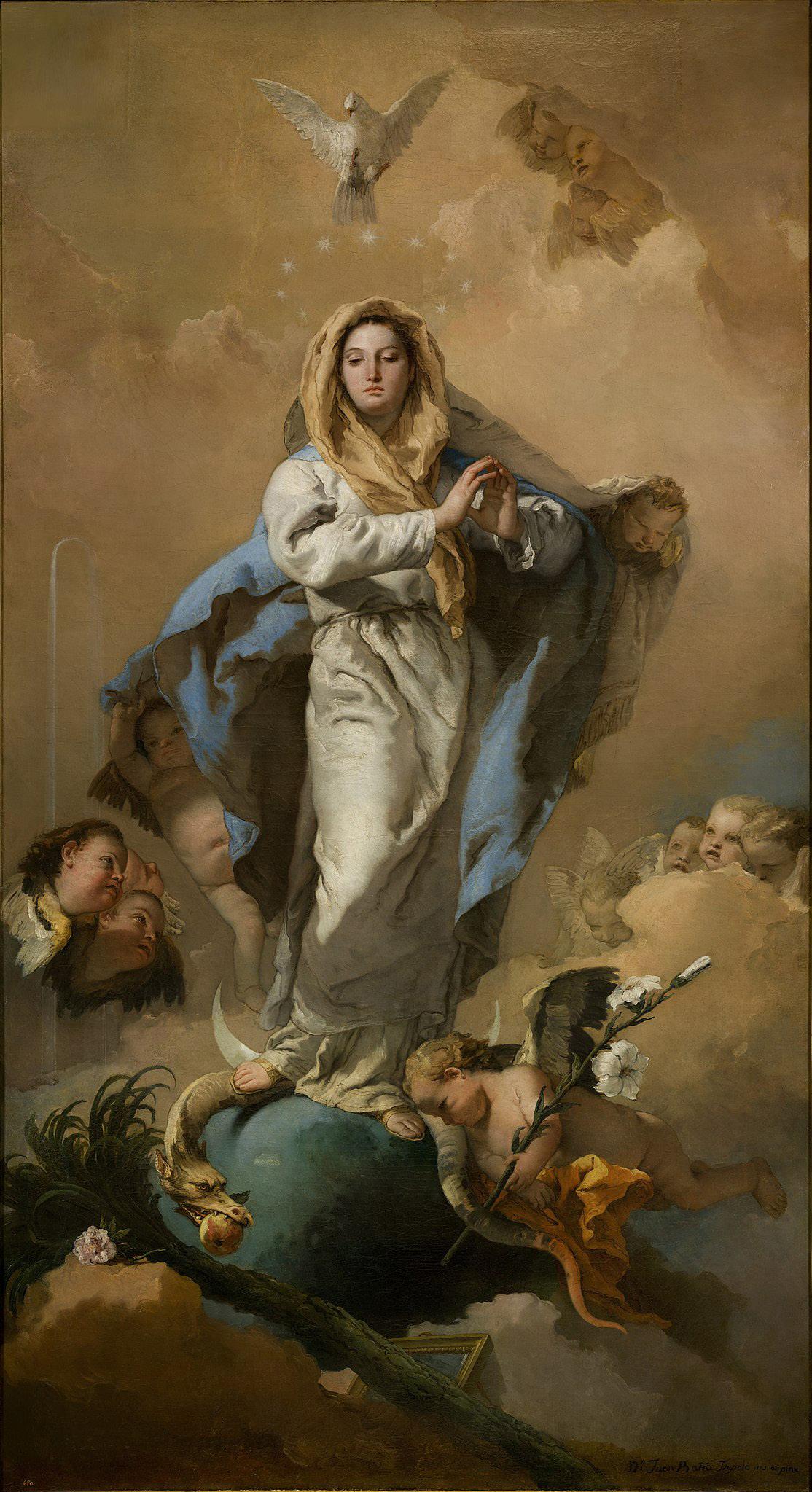
22 The
Record | December 2022
Brownson
The Immaculate Conception by Giovanni Battista Tiepolo
come a woman who will not be affected by the Original Sin of Adam and Eve. The answer to the question of Eve is Mary! She will be in total direct opposition to the devil from the moment of her conception. Here in the beginning of Scripture, we find a prophecy of the Virgin Mary’s Immaculate Conception! It is fitting that the mother of our Lord would be born this way. This belief is held by many Church fathers as early as the third century. St. Irenaeus writes: "In accordance with this design, Mary the Virgin is found obedient, saying, 'Behold the handmaid of the Lord; be it unto me according to your word.' But Eve was disobedient; for she did not obey when as yet she was a virgin. And even as she, having indeed a husband, Adam but being nevertheless as yet a virgin … having become disobedient, was made the cause of death, both to herself and to the entire human race; so also did Mary, having a man betrothed [to her], and being nevertheless a virgin, by yielding obedience, became the cause of salvation, both to herself and the whole human race. . . . And thus also it was that the knot of Eve’s disobedience was loosed by the obedience of Mary. For what the virgin Eve had bound fast through unbelief, this did the virgin Mary set free through faith."
Mary in her wondrous fidelity broke the vicious cycle of sin. She is "spes nostrae" our hope. Sin offers us everything we could ever want, but in the end only leads to more shame and despair. In the moment after our sin, God responds the same way he did in Genesis. As a loving father, he beckons Eve and without missing a step, makes way for a plan of reconciliation found in the protoevangelion. When we sin, God quickly offers us a door of mercy and we must make haste to say yes the same way Mary did. At every moment to which we can respond to God’s call to holiness and love, let us courageously echo the words of Mary, fiat mihi secundum verbum tuum "May it be done to me according to your word" (Luke 1:38).
What does this mean for us? We must imitate Mary as she imitates Christ. St. Maximilian wrote, "The Immaculata never had any stain of sin, which means that her love was always full, without flaws. She loved God with all her being, and love united Her with God in this perfect fashion from the first instant of her life, such that on the day of the Annunciation, the Angel could address her saying: 'Full of grace, the
Lord is with thee' [Lk 1:28]." Mary in her immaculate heart holds perfect interior freedom that makes inner struggles and divisions foreign to her. She is incapable of doubt, skepticism, indecision, or anything that wastes time. All the faculties of her soul are fully oriented towards the love of God. She is void of all hatred and selfish desires. How great a reason this is for us today to fly to her patronage daily!
In a world that is more divisive than ever, let us ask for the intercession of the Immaculate Conception to heal the wounds caused by sin and to unite our lands to be one in Christ, a healed humanity. How fitting that the bishops of the United States of America would proclaim Mary under the title of the Immaculate Conception to be the patroness of the whole country. It is to Jesus through Mary that hatred, violence and indifference will cease in the world. The Immaculate Heart of Mary will triumph over the culture of death, the disease of racism, and the industry of abortion. In light of this mystery, Jesus shows us that redemption is possible. The Blessed Virgin perfectly fulfills the purpose to which all of us are created: to know, love, and serve God and be transformed into the image of Christ.
Our deepest identity is not in what we do or what we look like, but to be loved by our Heavenly Father and to love from that outpouring. God works in Mary just as he does for us. "You are all-beautiful, my beloved, and there is no flaw in you" (Song of Songs 4:7). God’s plan is for my good and is at work even when I may not understand or see it all the way through. God will never tire in speaking to you that you are worthy, that you are good, and that you are loved. As we reflect on who is the Immaculate Conception, let us remember that who you are is more important than what you do. Let us go forth with a renewed conviction to make Mary’s mission to be our own: to announce the joyful news of God’s love and forgiveness and to bring all people to her Son
Oh Mary, conceived without sin, pray for us who have recourse to thee.
The Brownson Record | December 2022 23
~
Gian Gonzalez, The Immaculate Conception: Our Model of Holiness
Front cover: Photo in the Chapel of the Immaculate Conception by Michael Pray
Back Cover: Photo of the dome of the Chapel of the Immaculate Conception entitled Emitte Spiritum Tuum by Fr. Lawrence Lew, O.P.
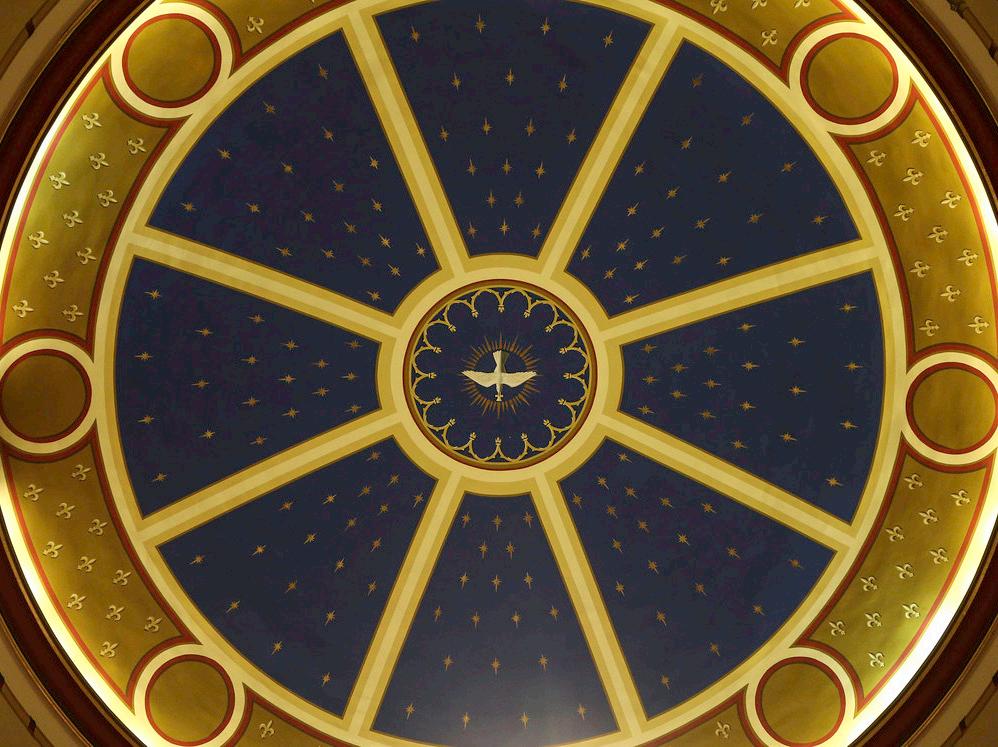
"Our deepest identity is not in what we do or what we look like, but to be loved by our Heavenly Father and to love from that outpouring."







 Photo of the Grotto by Michael Pray
Photo of the Grotto by Michael Pray

 Photo of a breviary by Joe Gallagher. CC BY SA
Photo of a breviary by Joe Gallagher. CC BY SA





